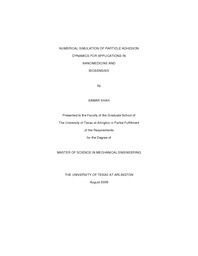
ATTENTION: The works hosted here are being migrated to a new repository that will consolidate resources, improve discoverability, and better show UTA's research impact on the global community. We will update authors as the migration progresses. Please see MavMatrix for more information.
Show simple item record
| dc.contributor.author | Shah, Samar | en_US |
| dc.date.accessioned | 2009-09-16T18:19:33Z | |
| dc.date.available | 2009-09-16T18:19:33Z | |
| dc.date.issued | 2009-09-16T18:19:33Z | |
| dc.date.submitted | January 2009 | en_US |
| dc.identifier.other | DISS-10343 | en_US |
| dc.identifier.uri | http://hdl.handle.net/10106/1760 | |
| dc.description.abstract | Multifunctional nanoparticles hold considerable promise as the next generation of medicine that allow for detection of early on-set of diseases and targeted therapy with minimal toxicity. To achieve targeted drug delivery, nanoparticles are usually functionalized with certain ligands (polymers) that bind specifically to a particular type of receptors on the endothelial cell surface, which are expressed exclusively during its diseased state. The ligand coated nanoparticles, loaded with drugs inside, transport in blood stream, and adhere to diseased cells via specific adhesion. However, this whole procedure becomes complicated due to simultaneous involvement of hydrodynamic force, adhesion force and Brownian force. In particular, the ligand-receptor interaction is a sophisticated chemical process. So, the property of functionalized ligands would play a crucial role to dictate the efficiency of the targeted drug delivery by providing targeted selectivity. Similarly, the shape and dimension plays a vital role in maximizing the binding efficiency of nanocarriers. To capture nanoparticle transportation and adhesion at nanoscale, a numerical tool is developed that describes the nanoparticle motion under vascular flow conditions. Computational modeling of targeted drug delivery via nanoparticles will offer insights to the dynamic delivery process, thus facilitate better design of nanocarriers to address the challenges of nanomedicine. The deposition process and distribution of nanoparticles under various flow rates and vascular geometry are explored. Another aspect of this developed tool is to characterize the performance of biosensors. Nanosensors are time and cost efficient, sensitive, and enable new applications in medicine, drug discovery, and environmental monitoring. Various nanosensor platforms have been proposed, such as planar electrodes, nanowire, and nanospheres. To fully realize the potentials of the nanosensor for biomarker/nanoparticle detection, however, several key research challenges must be addressed. In particular, Nanosensors are needed for detection of low concentration biomarker such as cancer marker for early disease detection. The goal of this work is to develop an understanding of the diffusion and binding process of biomarkers under fluid flow through a novel multiscale/multiphysics computational model. | en_US |
| dc.description.sponsorship | Liu, Yaling | en_US |
| dc.language.iso | EN | en_US |
| dc.publisher | Mechanical Engineering | en_US |
| dc.title | Numerical Simulation Of Particle Adhesion Dynamics For Applications In Nanomedicine And Biosensing | en_US |
| dc.type | M.S. | en_US |
| dc.contributor.committeeChair | Liu, Yaling | en_US |
| dc.degree.department | Mechanical Engineering | en_US |
| dc.degree.discipline | Mechanical Engineering | en_US |
| dc.degree.grantor | University of Texas at Arlington | en_US |
| dc.degree.level | masters | en_US |
| dc.degree.name | M.S. | en_US |
| dc.identifier.externalLink | http://www.uta.edu/ra/real/editprofile.php?onlyview=1&pid=1924 | |
| dc.identifier.externalLinkDescription | Link to Research Profiles | |
Files in this item
- Name:
- Shah_uta_2502M_10343.pdf
- Size:
- 3.690Mb
- Format:
- PDF
This item appears in the following Collection(s)
Show simple item record


